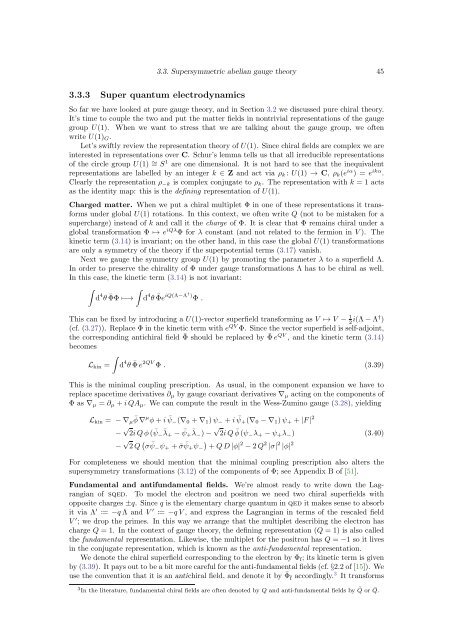The Bethe/Gauge Correspondence
The Bethe/Gauge Correspondence
The Bethe/Gauge Correspondence
You also want an ePaper? Increase the reach of your titles
YUMPU automatically turns print PDFs into web optimized ePapers that Google loves.
3.3. Supersymmetric abelian gauge theory 453.3.3 Super quantum electrodynamicsSo far we have looked at pure gauge theory, and in Section 3.2 we discussed pure chiral theory.It’s time to couple the two and put the matter fields in nontrivial representations of the gaugegroup U(1). When we want to stress that we are talking about the gauge group, we oftenwrite U(1) G .Let’s swiftly review the representation theory of U(1). Since chiral fields are complex we areinterested in representations over C. Schur’s lemma tells us that all irreducible representationsof the circle group U(1) ∼ = S 1 are one dimensional. It is not hard to see that the inequivalentrepresentations are labelled by an integer k ∈ Z and act via ρ k : U(1) → C, ρ k (e iα ) = e ikα .Clearly the representation ρ −k is complex conjugate to ρ k . <strong>The</strong> representation with k = 1 actsas the identity map: this is the defining representation of U(1).Charged matter. When we put a chiral multiplet Φ in one of these representations it transformsunder global U(1) rotations. In this context, we often write Q (not to be mistaken for asupercharge) instead of k and call it the charge of Φ. It is clear that Φ remains chiral under aglobal transformation Φ ↦→ e iQλ Φ for λ constant (and not related to the fermion in V ). <strong>The</strong>kinetic term (3.14) is invariant; on the other hand, in this case the global U(1) transformationsare only a symmetry of the theory if the superpotential terms (3.17) vanish.Next we gauge the symmetry group U(1) by promoting the parameter λ to a superfield Λ.In order to preserve the chirality of Φ under gauge transformations Λ has to be chiral as well.In this case, the kinetic term (3.14) is not invariant:∫∫d 4 θ ¯ΦΦ ↦−→ d 4 θ ¯Φe iQ(Λ−Λ†) Φ .This can be fixed by introducing a U(1)-vector superfield transforming as V ↦→ V − 1 2 i(Λ − Λ† )(cf. (3.27)). Replace Φ in the kinetic term with e QV Φ. Since the vector superfield is self-adjoint,the corresponding antichiral field ¯Φ should be replaced by ¯Φ e QV , and the kinetic term (3.14)becomes∫L kin = d 4 θ ¯Φ e 2QV Φ . (3.39)This is the minimal coupling prescription. As usual, in the component expansion we have toreplace spacetime derivatives ∂ µ by gauge covariant derivatives ∇ µ acting on the components ofΦ as ∇ µ = ∂ µ + i QA µ . We can compute the result in the Wess-Zumino gauge (3.28), yieldingL kin = − ∇ µ ¯φ ∇ µ φ + i ¯ψ − (∇ 0 + ∇ 1 ) ψ − + i ¯ψ + (∇ 0 − ∇ 1 ) ψ + + |F | 2− √ 2i Q φ ( ¯ψ −¯λ+ − ¯ψ +¯λ− ) − √ 2i Q ¯φ (ψ − λ + − ψ + λ − )− √ 2 Q ( (3.40)σ ¯ψ − ψ + + ¯σ ¯ψ)+ ψ − + Q D |φ| 2 − 2 Q 2 |σ| 2 |φ| 2For completeness we should mention that the minimal coupling prescription also alters thesupersymmetry transformations (3.12) of the components of Φ; see Appendix B of [51].Fundamental and antifundamental fields. We’re almost ready to write down the Lagrangianof sqed. To model the electron and positron we need two chiral superfields withopposite charges ±q. Since q is the elementary charge quantum in qed it makes sense to absorbit via Λ ′ := −q Λ and V ′ := −q V , and express the Lagrangian in terms of the rescaled fieldV ′ ; we drop the primes. In this way we arrange that the multiplet describing the electron hascharge Q = 1. In the context of gauge theory, the defining representation (Q = 1) is also calledthe fundamental representation. Likewise, the multiplet for the positron has Q = −1 so it livesin the conjugate representation, which is known as the anti-fundamental representation.We denote the chiral superfield corresponding to the electron by Φ f ; its kinetic term is givenby (3.39). It pays out to be a bit more careful for the anti-fundamental fields (cf. §2.2 of [15]). Weuse the convention that it is an antichiral field, and denote it by ¯Φ¯f accordingly. 3 It transforms3 In the literature, fundamental chiral fields are often denoted by Q and anti-fundamental fields by ˜Q or ¯Q.
















